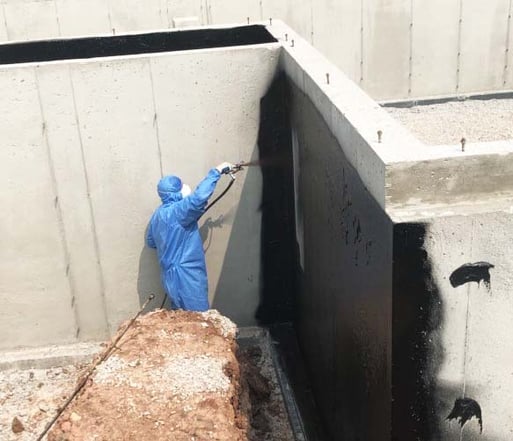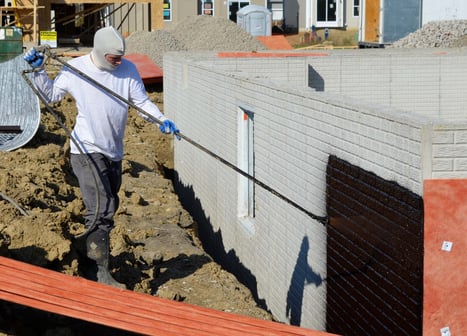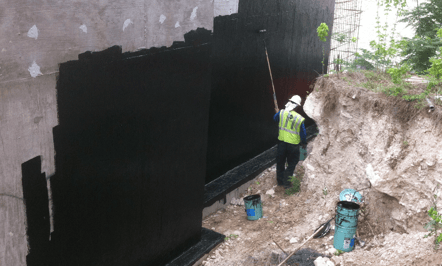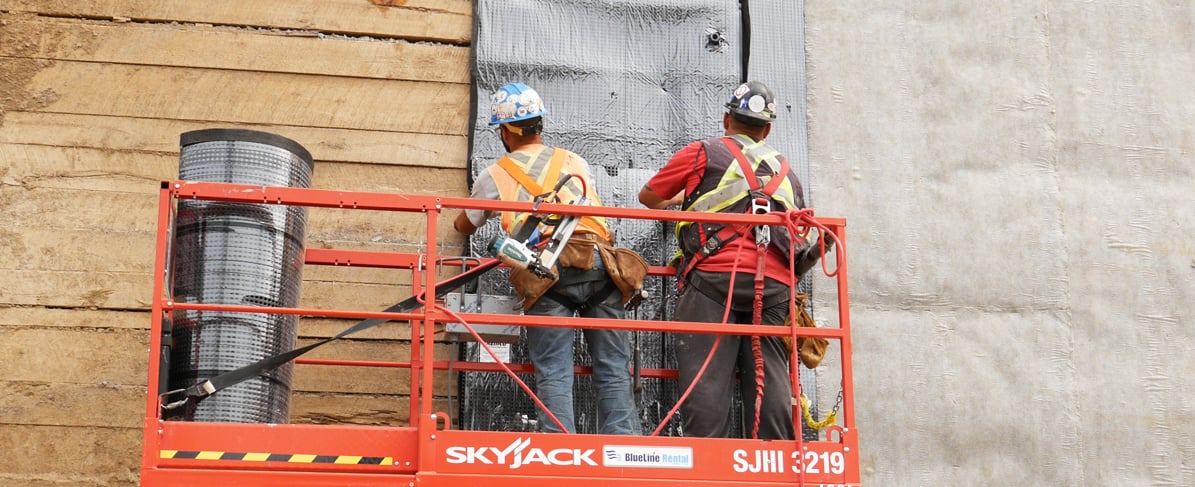Vertical waterproofing for residential and multi-family projects can be difficult with the number of products available in the industry, their unique installation instructions, and the speed often required to complete jobs. Thankfully, there are some easy tips and tricks to ensure your application is watertight and prevent callbacks. Read on for some frequently asked questions about fluid-applied waterproofing, as well as common mistakes to avoid on your next project.
Common Questions About Applying Fluid Waterproofing Membranes
Here are the questions I hear most often related to liquid waterproofing membranes and their answers to help guide your project preparation and product application:
What Pressure Should I Use When Spray Applying?
When working with polymer-modified asphalt products, most application instructions will offer a range between 2200 and 2800 psi (pounds per square inch) for spraying. Because products, equipment, and project conditions will vary, be sure to refer to the application instructions and data sheets that come with your product or are available on the manufacturer’s website to ensure you follow the correct guidelines.
 What Tip Size Should Be Used?
What Tip Size Should Be Used?
The recommended size of the sprayer tip will depend on the selected product and environmental factors. The product application instructions should contain specific recommendations since the product’s viscosity, which may be impacted by temperature, will affect the proper tip size selected.
What Size Pump Do I Need?
Like the tip size, your pump choice will depend on the product and the project. When considering sprayer size, smaller units usually only spray out of 5-gallon pails of material, and larger sprayers can spray out of both the 55-gallon drums and the 5-gallon pails of material.
What Temperature Does The Product Have To Be?
Manufacturers will outline the required product and outside temperature ranges for proper installation. Environmental factors, such as wind speed and precipitation, can impact the performance and cure time of waterproofing products, so thoroughly review manufacturer’s literature to line up your application with proper jobsite conditions.
Most products should be stored and kept above 50ºF (10ºC) , although some membranes can be applied in temperatures as low as 20ºF (-6 ºC), provided there is no frost on the wall to act as a bond breaker.
Similarly, some products benefit from the use of a heat exchanger, per manufacturer’s recommendation, which takes the product from ambient temperatures up to 110-160ºF (43-71ºC). While this process adds some extra setup cost, it speeds the cure time and enables application in cold temperatures.
Common Errors Made in the Field Using Fluid Waterproofing Membranes

Application errors can be prevented by ensuring your crew understands the product and the correct installation process of your job. Below are the common mistakes that can happen in the field to watch out for.
- Inadequate Substrate Preparation: Proper substrate preparation is the first step to ensuring the full adhesion and performance of a waterproofing membrane, and yet it is often skipped or mishandled. Referencing the product’s application instructions will offer insight on the necessary substrate and environmental conditions for a successful job. For example, check for any existing honeycombs or cracks and sweep the entire wall and footing wall joints so they are free of dust, dirt, and debris.
- Incorrect Application Thickness: Regardless of whether your product is spray or roll-applied, you should always use a notch-film gauge on the wet membrane to measure its thickness. Check the mil-thickness multiple times throughout the course of application and adjust the product thickness accordingly to consistently meet the manufacturer’s required coverage. If a fluid waterproofing membrane is applied too thin or too thick, the product may not have the desired waterproofing performance. This happens in spray applications if the applicator is moving too slowly or too quickly or standing too close or too far away from the vertical wall surface than is specified in the installation instructions.
What Happens When These Errors Aren’t Resolved?
Inadequate substrate preparation and improper membrane thickness can lead to a lack of adhesion or delamination of the product from the wall, which essentially lessens the protection and shortens the life span of the product. Even seemingly minor errors during waterproofing applications can cause big headaches in the long run for the builder, the owner and the building’s occupants in the form of moisture penetration, mold, mildew and ultimately warranty claims and call-backs to repair the damage.
What Is the Difference Between Spray and Roll-On Applications?
Residential waterproofing membranes can be applied using a sprayer or a roller. The resulting performance of the applications, if done correctly, are comparable, so the choice is really up to contractor preference.
Spray Applications
Traditional waterproofing membranes were long applied with rollers, but as technology advanced, spraying with a hydraulic pump and hose became the predominant method. Today, spray applications are the most popular choice in the residential and multi-family sectors for their speed and efficiency. While requiring more equipment for installation, contractors tend to prefer using a sprayer for several reasons:
- Uniform Coverage: Because you choose the type of sprayer and tip needed for the project, you have more control over how the membrane is applied, allowing for a consistent coverage rate.
- Labor-Friendly: Applicators using a sprayer will be able to reach a larger surface area from one place and will have a less labor-intensive job.
- Faster Curing Times: The product being sprayed under pressure through a spray tip helps polymer modified asphalt for most waterproofing membranes cure faster.

Roll-On Applications
With the many advantages of spraying a waterproofing membrane, rolling is no longer a common practice, as it can be time-consuming and messy. However, with the construction labor shortage, roll-applications can be enticing for beginner applicators since there is minimal learning curve. Contractors who continue to use this method typically have been doing it for decades and therefore have the procedures down efficiently and may not want the added expense of spray equipment.
What You Should Know About the Co-Spraying Method
In residential waterproofing applications, co-spraying can be used to speed the membrane cure time. Through a special co-spray or low-pressure pump and a modified gun, the process breaks the emulsion of the material with a calcium chloride solution so that upon spraying, there is a touchable, semi-cured membrane almost immediately.
This time factor helps fast-track construction and reduces the potential for washout if there is inclement weather. Plus, co-spraying only adds about two cents per square foot to the overall product cost, so it is not a financial strain.
Despite these benefits, however, most residential and multifamily waterproofing contractors prefer to spray wet for their projects as the extra pump, hoses, and chemicals add more complexity to their jobs.
Always Be Prepared Before Starting Your Project
Although there are a number of product, equipment, and jobsite factors to consider, a successful waterproofing project is feasible with proper preparation and application. Upfront training can mitigate field errors, and manufacturers offer data sheets and application instructions for easy reference at a moment’s notice.
Utilizing these documents and properly executing the product installations will preserve the long-term waterproofing protection of the home, saving money on future warranty claims for the contractor and maintenance costs for the building owner.






